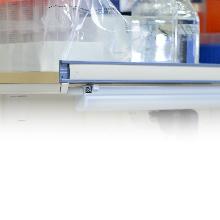Blurring the boundaries
Inspired by biology, physicist Dr. Alexandra Tayar is transforming material science
New scientists

Dr. Alexandra Tayar
Dr. Alexandra Tayar grew up in Rehovot, close to the Weizmann Institute campus. “My mother always jokes that it took me 30 years to cross the road,” she says.
After completing her undergraduate degree in physics at Tel Aviv University, Dr. Tayar moved to the Weizmann Institute of Science, where she did her MSc and PhD degrees in the lab of Prof. Roy Bar-Ziv in the Department of Materials and Interfaces. Now, after a four-year postdoctoral fellowship at the University of California, Santa Barbara, she is returning to where it all started—this time as a principal investigator in the Department of Chemical and Biological Physics.
A self-professed soft matter enthusiast, Dr. Tayar is fascinated by the intersection of biology and physics and the design of biologically inspired materials that can perform life-like functions at the molecular scale. In her lab, she borrows proteins and other building blocks from living systems and restores their function outside the cell under conditions and concentrations that allow the assembly of new complex materials. The unique capabilities of the developed system, especially its ability to be biochemically controlled, provide insight into possible mechanisms by which nanometer-sized molecules drive macroscale order.
“Evolution has optimized biological building blocks to be very efficient in energy consumption and motility on a microscopic scale,” says Dr. Tayar. “We want to borrow biological features to make a synthetic entity that can move on its own.”
Tiny robots, enormous potential: A better understanding of the inner workings of these systems could help scientists design self-propelled and efficient soft robots—nano-machines that operate on a microscopic scale. Prototypes for biorobots already exist in living systems, as in the case of kinesin motors, which are tiny protein molecules that travel over microtubules in the brain with chemicals on their backs. Given their ability to adapt to the external environment, squeeze into small areas, and change with mechanical pressure, soft robots could be engineered for drug delivery, medical devices, and microscopy.
By integrating biological principles into physics, Dr. Tayar envisions a significant impact on the physics community.
“Biology gave us new biochemical building blocks that can be used to study the physics and chemistry of materials. I want to use this new framework to blur the boundaries between what occurs inside the cells, and what can be done in the laboratory.” She eventually hopes to build an autonomous system—a small robot, for example—that can adapt to external conditions and has enough feedback and complexity to complete a task.
Attracted to exploring the unknown, and with a propensity for math and physics, Dr. Tayar began her career in a research unit during her military service. Upon concluding her service, she debated whether to study medicine or physics. Once she embarked on the latter, she never looked back—all the way through her PhD in Prof. Bar-Ziv’s lab, where she fell in love with the world of multidisciplinary research, specifically the combination of biology and physics.
“Roy was always asking what biology could do for physics rather than the other way around,” she recalls, adding that he also taught her to not be afraid of taking on challenges.
Working in the Bar-Ziv lab had another major impact on her life. It was here she met her husband, Dr. Eyal Karzbrun. The two did their postdoctoral fellowships at UC Santa Barbara, and are returning together to the Weizmann Institute, this time heading their own labs. As for her role as a woman scientist and a mother, Dr. Tayar notes that the flexibility of science and having a supportive partner, who takes an equal role in the family, allows her to care for their son while pursuing academic excellence in her career.
Elements for innovative science: Dr. Tayar plans to create an inclusive, friendly lab with an excellent academic level, where students and scientists can make choices that will benefit both their families and scientific careers. She also intends to foster a supportive and empowering environment for all.
“Many times, women and minorities don’t believe in themselves. I want to help them find and apply to fellowships, encourage them to speak at conferences, and try for things they don’t think they can do,” she explains. Much of her inspiration comes from Prof. BarZiv. “Roy pushed me and empowered me. Thanks to him, I learned how to motivate and excite people—this is one of his best qualities.”
In addition to being inclusive and supportive, the Tayar lab will also be multidisciplinary, bringing together physicists, biochemists, material scientists, and chemical engineers to uncover the organizational principles of active, biologically inspired materials.
Though she will miss running on the California beaches and exploring tide pools with her son, Dr. Tayar is looking forward to returning to Israel. “I’ve missed the people and the ambiance of Israel—the warmth of the people, and how you can click with someone you just met in minutes.”
“Returning to Weizmann is exciting,” she says. “The Institute is an exceptional place. Its environment is unprecedented. The quality of the researchers from the master’s level through professorships is amazing. I always had the best scientific dialogues at Weizmann.”
Education and select awards:
• BSc, Tel Aviv University (2010) • MSc (2012) and PhD (2017), Weizmann Institute of Science
• Postdoc, University of California, Santa Barbara (2018-2022)
• Simons Foundation Fellow of the Life Sciences Research Foundation (2018- 2021); Clore Fellow of the Israel National Postdoctoral Award Program for Advancing Women in Science (2018-2021)








